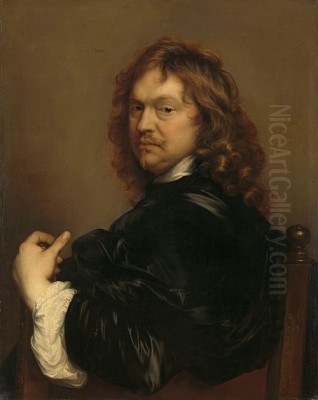
Adriaen Hanneman stands as a significant figure in the rich tapestry of the Dutch Golden Age, a period renowned for its artistic flourishing. Primarily celebrated as a portrait painter, Hanneman navigated the complex artistic and political landscapes of both the Netherlands and England during the tumultuous 17th century. His career is particularly noted for his close association with the style of the Flemish master Sir Anthony van Dyck and his role as a chronicler of royalty and aristocracy, especially those connected to the exiled Stuart court. Born in The Hague, Hanneman's life and work offer a fascinating glimpse into the cross-cultural artistic exchanges and the demands of patronage in his time.
Early Life and Artistic Formation in The Hague
Adriaen Hanneman was born in The Hague around 1603 or 1604. His origins lay within a prosperous Catholic family, providing him with a degree of social standing from the outset. The Hague, as the administrative center of the Dutch Republic and the seat of the House of Orange, was a hub of diplomatic activity and aristocratic life, creating a fertile ground for portrait commissions. It was in this environment that Hanneman began his formal artistic training.
In 1619, he became an apprentice to the respected Hague portraitist Anthony van Ravesteyn. Van Ravesteyn himself was a prominent painter, known for his group portraits of civic guards and individual likenesses characterized by their solid technique and dignified representation. Under Van Ravesteyn's tutelage, Hanneman would have learned the fundamentals of portrait painting, including drawing, paint handling, and the conventions of representing status and identity prevalent in Dutch art. The Hague's art scene at this time was also shaped by figures like Michiel van Mierevelt, whose prolific output had set a high standard for portraiture in the region. Hanneman's early development occurred within this established tradition.
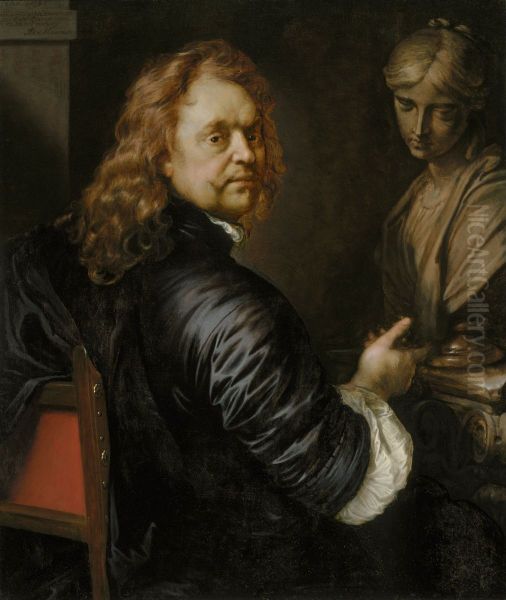
His Catholic background is noteworthy in the predominantly Protestant Dutch Republic. While Catholicism was tolerated, it could sometimes present social or professional hurdles. However, Hanneman's family connections and talent appear to have allowed him to navigate this aspect successfully, eventually leading him to work for patrons across the religious and political spectrum. His foundational years in The Hague provided him with the technical skills and social awareness necessary for a successful career in portraiture.
The London Years: Immersion in the Van Dyckian Milieu
Around 1626, seeking broader opportunities and perhaps drawn by the magnetic pull of the English court, Adriaen Hanneman relocated to London. This move proved pivotal for his artistic development. England, under King Charles I, was a center of sophisticated court culture, and the King was an avid art collector and patron. The dominant artistic force in London during Hanneman's stay was Sir Anthony van Dyck, the Flemish painter who had revolutionized English portraiture.
Van Dyck arrived in London in 1632 (though he had visited earlier) and quickly became the principal painter to the King. His portraits, characterized by their effortless elegance, refined poses, fluid brushwork, and psychological depth, set an entirely new standard for aristocratic representation. Hanneman entered this vibrant artistic environment and is widely believed to have worked in Van Dyck's studio, perhaps as an assistant or a highly skilled collaborator. The influence of Van Dyck on Hanneman's style became profound and enduring.
During his approximately sixteen years in England, Hanneman absorbed the Van Dyckian aesthetic. He learned to emulate the graceful postures, the rich rendering of fabrics (particularly silks and satins), and the cool, aristocratic reserve that defined Van Dyck's work. While in London, he would have also encountered the work of other portraitists active at court or in the city, such as the Dutch-born Daniel Mytens, who was Van Dyck's predecessor as court painter, and Cornelius Johnson (Cornelis Janssens van Ceulen), another painter of Dutch extraction known for his sensitive and detailed likenesses. Hanneman's time in London was thus a period of intense learning and stylistic assimilation, equipping him with a fashionable, courtly style highly sought after by elite patrons.
Return to The Hague: Establishing a Premier Practice
Around 1640, coinciding perhaps with the escalating political tensions in England that would lead to the Civil War, Adriaen Hanneman returned to his native city, The Hague. He brought back with him the sophisticated, internationally recognized style he had honed in London. This Van Dyckian manner immediately distinguished him in the local art scene and positioned him perfectly to cater to the tastes of the Dutch aristocracy and the many foreign diplomats and dignitaries residing in The Hague.
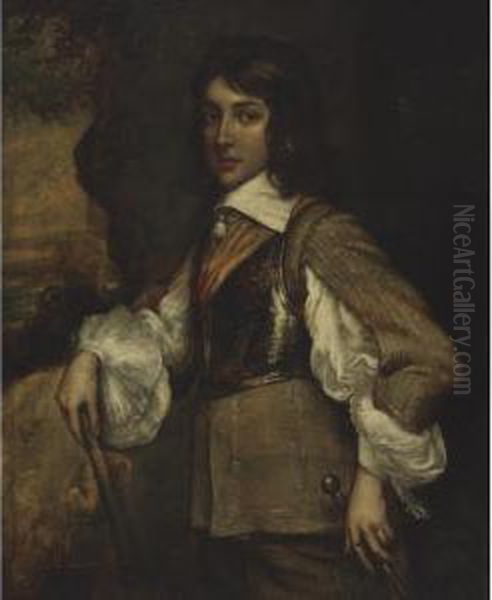
Upon his return, Hanneman quickly established himself as one of the city's leading portraitists. In 1640, he married Maria van Eynden, the daughter of a local silversmith, further integrating himself into the city's artisanal and social networks. His professional standing was formally recognized in 1645 when he became a member of the Guild of Saint Luke in The Hague. This membership was essential for practicing legally and taking on apprentices.
Hanneman's studio became highly successful, attracting prestigious commissions. His ability to imbue his sitters with an air of elegance and status, reminiscent of the grand portraits of the English court, was particularly appealing. He faced competition from other talented Hague painters, such as Jan Mytens (nephew of Daniel Mytens), who also specialized in portraiture, but Hanneman's direct experience with the Van Dyck studio and his mastery of that specific style gave him a distinct advantage, especially among patrons seeking an international flair. His return marked the beginning of his most productive and influential period.
Artistic Style: Elegance, Refinement, and the Shadow of Van Dyck
Adriaen Hanneman's artistic style is inextricably linked to that of Anthony van Dyck. He is often considered one of Van Dyck's most accomplished followers, mastering the visual language of aristocratic portraiture that the Flemish master had perfected. Hanneman's paintings typically feature elegant, elongated figures, often posed against neutral or simple architectural backgrounds, focusing attention on the sitter. He excelled at capturing the likeness of his subjects while simultaneously idealizing them according to contemporary notions of grace and nobility.
A key characteristic of Hanneman's work is the meticulous rendering of clothing and accessories. He paid great attention to the textures of fabrics – the shimmer of silk, the richness of velvet, the intricate detail of lace – which served not only as markers of wealth and status but also contributed to the overall decorative effect of the portrait. His figures often adopt poised, slightly reserved stances, conveying a sense of decorum and social standing. The hands, in particular, are often rendered with delicate elegance, a hallmark also seen in Van Dyck's portraits.
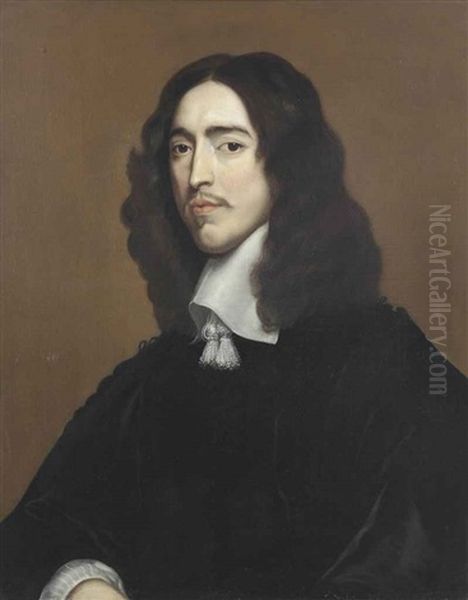
While the influence of Van Dyck is undeniable, Hanneman developed certain individual traits. Art historians note that Hanneman's color palette, while still sophisticated, often tended towards slightly cooler or brighter tones compared to the warmer, more Venetian-inspired hues sometimes employed by Van Dyck. His brushwork could be somewhat tighter and more precise than the fluid, seemingly effortless strokes of his mentor, although he could also achieve remarkable painterly effects. Compared to the robust realism of Dutch contemporaries like Frans Hals or the profound introspection found in Rembrandt van Rijn's portraits, Hanneman's work represents a different sensibility – one geared towards courtly elegance and international sophistication rather than bourgeois naturalism or deep psychological exploration.
The comparison with Van Dyck, however, also led to criticism, both during his time and later, with some viewing him primarily as an imitator. While the stylistic debt is clear, many of Hanneman's portraits stand on their own merits, demonstrating his considerable skill in composition, characterization, and technique. He successfully adapted the Van Dyckian mode to the context of The Hague, creating a distinct body of work that catered to the specific demands of his clientele.
Patronage: Chronicler of Courts in Exile and Dutch Nobility
Hanneman's success was significantly fueled by his access to high-status patrons, both Dutch and international. His London-honed style made him particularly attractive to the members of the English royal family and their loyalists who sought refuge in The Hague during and after the English Civil War. The Hague became a center for the exiled Stuart court, and Hanneman became one of their preferred portraitists.
He famously painted several portraits of Mary, Princess Royal (daughter of Charles I and wife of Prince William II of Orange). His depictions of her capture her regal bearing and the fashionable attire of the period. He also painted her younger brother, Henry, Duke of Gloucester. These commissions were not just artistic endeavors; they were political statements, reinforcing the status and legitimacy of the exiled royals. Hanneman's portraits helped maintain their image during a period of uncertainty. It is likely he also painted Charles II during his time on the continent before the Restoration.
Simultaneously, Hanneman served the Dutch elite. He received commissions from the House of Orange, most notably painting a charming portrait of the young Prince William III (later King of England) at the age of four. This work, now in the Rijksmuseum, showcases his ability to handle child portraiture with sensitivity while still adhering to conventions of status. He also painted prominent Dutch figures, likely including members of the Huygens family, such as the influential statesman and poet Constantijn Huygens, who was a major cultural figure in The Hague and an art connoisseur with connections to both the Dutch and English courts.
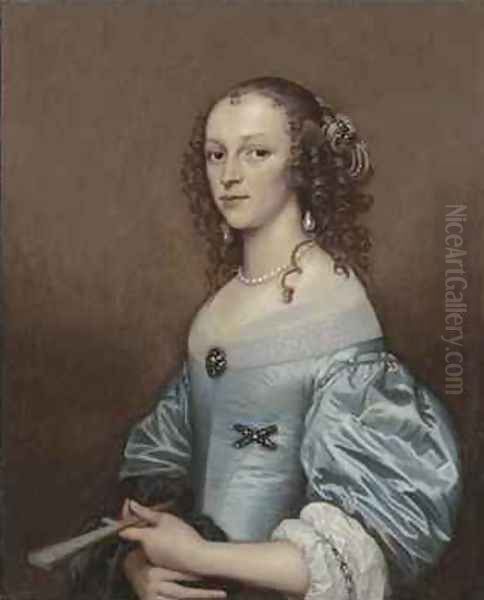
Hanneman's ability to navigate these different circles of patronage – the exiled Stuarts, the House of Orange, and the Dutch aristocracy – speaks to his diplomatic skills as well as his artistic talent. His studio became a key site for the production of images that defined the social and political elite of The Hague in the mid-17th century.
The Confrerie Pictura: Leadership in the Hague Art World
Beyond his individual artistic practice, Adriaen Hanneman played a significant role in the organization of the art world in The Hague. In the mid-17th century, tensions arose within the traditional Guild of Saint Luke, which encompassed various crafts besides painting. Several prominent painters felt that their status and interests were not adequately represented by the old guild structure. They sought to establish a new, more exclusive organization dedicated solely to the art of painting, aiming to elevate its status closer to that of a liberal art rather than a mere craft.
In 1656, Hanneman was among the leading figures who broke away from the Guild of Saint Luke to establish the "Confrerie Pictura" (Brotherhood of Painters). This move was a significant assertion of the painters' professional identity and ambitions. Hanneman was not just a founding member; he served as the first dean (or head) of the Confrerie, a position he held again in later years. Other prominent Hague painters involved in the Confrerie likely included figures like Jan de Baen, who would become a leading portraitist in the city after Hanneman. Samuel van Hoogstraten, though more associated with Dordrecht, also had connections to the Hague art scene and the Confrerie's intellectual leanings.
The founding of the Confrerie Pictura aimed to regulate the profession more strictly, maintain high standards of quality, and enhance the social standing of painters. They established their own meeting rooms and likely organized drawing classes or lectures. Hanneman's leadership role underscores his respected position among his peers and his commitment to advancing the status of his profession. This involvement in guild politics demonstrates that he was not just a painter focused on his commissions but also an active participant in the institutional framework of the Dutch art world. His earlier departure from the Guild of St Luke, mentioned in some sources around 1648, might reflect earlier dissatisfaction that culminated in the 1656 split.
Analysis of Key Works
Several key works exemplify Adriaen Hanneman's style and subject matter. His Self-Portrait (c. 1656, Rijksmuseum, Amsterdam) shows the artist presenting himself with confidence and sophistication, holding gloves, a common accessory denoting gentility. The handling of the face shows his skill in capturing a likeness, while the attire and pose reflect the elegant Van Dyckian influence he applied to himself as much as to his sitters.
The Portrait of Mary, Princess Royal and Princess of Orange (c. 1659, Scottish National Gallery, Edinburgh) is a prime example of his royal portraiture. Mary is depicted three-quarter length, dressed in lustrous satin, her pose conveying regal dignity. The cool lighting and the meticulous rendering of the fabric are characteristic of Hanneman's style. The portrait serves as both a personal likeness and an icon of royal status during her widowhood and her role as regent for her young son.
Hanneman's Portrait of Henry, Duke of Gloucester (c. 1653, Dulwich Picture Gallery, London) similarly captures the youthful prince with an air of aristocratic refinement, despite the turbulent circumstances of his family. The slightly melancholic expression perhaps hints at the challenges faced by the exiled Stuarts. The painting showcases Hanneman's ability to blend formal representation with a subtle sense of character.
The Portrait of William III, Prince of Orange, at the Age of Four (c. 1654, Rijksmuseum, Amsterdam) is notable for its depiction of the future king as a child. Dressed in elaborate attire suitable for his rank, the young prince holds an orange, a symbol of his dynasty. Hanneman manages to convey both the innocence of childhood and the weight of dynastic expectation.
A more unusual work is Post-mortem portrait of Mary I Stuart with a servant (c. 1664, Mauritshuis, The Hague). This painting depicts the deceased Princess Mary lying in state. It's a somber, commemorative work that differs from his standard life portraits but still employs his skill in rendering fabrics and creating a dignified atmosphere, albeit a mournful one. These works collectively demonstrate Hanneman's range within portraiture, his technical proficiency, and his role in documenting key figures of his era.
Relationships with Contemporary Painters
Adriaen Hanneman's career unfolded within a vibrant network of artistic relationships, marked by influence, collaboration, and competition. His connection with Anthony van Dyck was undoubtedly the most formative, transitioning from potential student or assistant to a leading practitioner of the Van Dyckian style in the Netherlands. This relationship defined much of his artistic identity.
In The Hague, he operated alongside other notable portraitists. Anthony van Ravesteyn was his teacher, representing the established tradition he emerged from. Jan Mytens was a direct contemporary and competitor in the lucrative market for aristocratic portraits in The Hague. While both worked in elegant styles, Hanneman's direct London experience likely gave him an edge in certain circles. He also likely interacted with artists specializing in other genres who were active in The Hague or associated with the Confrerie Pictura, such as Caspar Netscher, known for his refined genre scenes and later portraits, who settled in The Hague in 1662. Jan de Baen emerged as another significant portrait painter in The Hague, eventually succeeding Hanneman in prominence.
Hanneman's style can be contrasted with the leading portraitists in other Dutch cities. His cool elegance differs markedly from the dynamic brushwork and psychological immediacy of Frans Hals in Haarlem, or the profound chiaroscuro and emotional depth of Rembrandt in Amsterdam. While Hanneman likely knew of these masters, his artistic aims and clientele were different. He also operated in a different sphere from the Utrecht Caravaggisti like Gerard van Honthorst, although Honthorst also undertook court commissions, sometimes competing for similar patrons earlier in the century. Hanneman's position is best understood within the specific context of The Hague's courtly and diplomatic milieu, and his style compared to other international court painters like Peter Lely, who succeeded Van Dyck in England and whose style shows parallel developments. Other major Dutch portraitists like Bartholomeus van der Helst or Jacob van Loo in Amsterdam represented the tastes of the wealthy merchant class, often favoring a more detailed and opulent realism than Hanneman's aristocratic restraint.
Later Life, Legacy, and Historical Assessment
Adriaen Hanneman continued to be active as a painter in The Hague throughout the 1650s and 1660s. Following the death of his first wife, Maria van Eynden, he married Alida Bezemer in 1669. This second marriage produced three children. Despite his success and prestigious commissions, his financial situation in later life may not have been entirely secure. Some accounts suggest his estate upon his death in 1671 was relatively modest, valued at around 1000 guilders. This might indicate that while he earned well, he also lived expensively, or perhaps faced declining commissions or health issues towards the end of his life.
Hanneman's immediate legacy included influencing younger painters in The Hague who adopted aspects of his elegant style. His role in co-founding and leading the Confrerie Pictura also had a lasting impact on the professional organization of artists in the city. However, his long-term reputation has been somewhat overshadowed by his close association with Van Dyck. While acknowledged as a highly skilled painter, he is often discussed primarily in relation to his more famous mentor.
Historically, Adriaen Hanneman is valued as a key figure in transmitting the Van Dyckian style of portraiture to the Netherlands and adapting it for a Dutch and international clientele in The Hague. He holds an important place as a chronicler of the exiled Stuart court and the House of Orange during a critical period. His works provide invaluable visual records of these historical figures, rendered with technical skill and aristocratic grace. While perhaps not possessing the innovative genius of a Rembrandt or a Hals, Hanneman was a master craftsman and a highly successful practitioner within his chosen specialty, contributing significantly to the diverse landscape of Dutch Golden Age painting. His ability to bridge the artistic worlds of London and The Hague remains a defining feature of his career.
Conclusion: A Bridge Between Nations and Styles
Adriaen Hanneman occupies a unique and important position in 17th-century art history. As a Dutch painter deeply influenced by the Flemish master Anthony van Dyck during his extended stay in London, he became a crucial conduit for the transfer of courtly portrait styles between England and the Netherlands. His return to The Hague established him as a leading portraitist, sought after by the Dutch aristocracy, the House of Orange, and, significantly, the exiled members of the British royal family.
His paintings are characterized by their elegance, refined technique, and skillful rendering of status, successfully capturing the sophisticated tastes of his elite clientele. While operating in the shadow of Van Dyck, Hanneman developed a recognizable manner of his own, marked by a slightly cooler palette and precise execution. Beyond his artistic output, his role as a founder and leader of the Confrerie Pictura in The Hague highlights his standing among his peers and his contribution to the professionalization of art in the city.
Though perhaps not ranked among the very highest tier of Dutch Golden Age innovators, Adriaen Hanneman was a master of his craft and a vital figure in the cultural life of The Hague. His portraits remain essential visual documents of the personalities and politics of his time, offering a window into the interconnected worlds of Dutch society and European court culture. He remains a testament to the rich cross-currents of influence that shaped the art of the Dutch Golden Age.